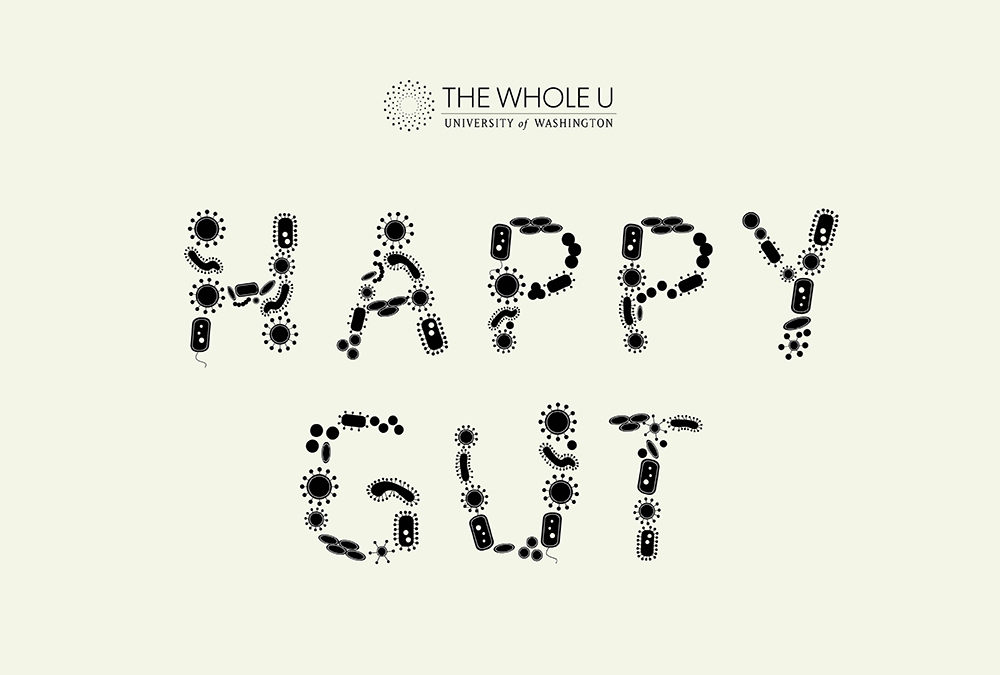
Happy Gut, Healthy Life. Eating for a Healthy Gut
Continuing research shows that micro biome (the trillions of tiny microbes in our digestive tract) has a huge impact on our metabolism, immune system, inflammation in our bodies, cravings, and diseases affecting overall health and well-being.
The biome lines our digestive tract like a protective film. When the biome is healthy, it provides a protective barrier in addition to allowing us to get nutrients from foods. Flora balance is important for proper digestion, synthesis of vitamins, recirculating of hormones by the liver, preventing colonization by pathogens (disease), and short chain fatty acid production.
Dysbiosis is when the healthy gut biome is altered, setting us up for common gastrointestinal, chronic inflammation, and other diseases, as well as obesity.
The Western Diet (Standard American Diet)—high in trans-fat, hydrogenated fats, high sugar, low fiber and overly processed foods (altered and preserved)—is a major cause of dysbiosis of the microbia. Repeated consumption of antibiotics is another major cause of dysbiosis in our society.
It sounds grim. But we can change our gut biomes and improve our health. The following action plan will help you change your gut biome and restore gut health.
- Eat only whole, pure foods.
Highly processed food is loaded with high fructose corn syrup, added sugars, and unhealthy fats.
- Cut out foods with added sugar for now. Avoid high fructose corn syrup entirely.
High amounts of sugar and high fructose corn syrup feed yeast and other unhealthy bacteria in the biome. They then grow out of proportion and crowd out the healthier bacteria. Yeast and unhealthy bacteria demand to be fed, therefore causing the overeating of more harmful foods. As you omit these, add cloves of garlic (or garlic supplement) to your diet daily. Garlic gets rid of the yeast overgrowth.
- To help you better digest food, consume organic, unpasteurized apple cider vinegar.
- Take a good-quality pro-biotic daily (5-10 billion CFU’s and 10-15 strains). Variety is a key to establishing a healthy gut biome.
- Next, feed the healthy bacteria. They grow well with a high fiber diet of whole foods.
- Dietary fibers are prebiotics. They are necessary for bacteria fermentation that allows them to grow. Some of the most powerful prebiotics are inulin, arabinogalactans and fructooligosaccharieds (FOS). They are found in asparagus, carrots, garlic, Jerusalem artichoke, jicama, leeks, onion, radishes and tomatoes.
- Strive to include 7+ servings a day of vegetables and fruit.
- Eat raw nuts and unsweetened nut butters.
- Add healthy fats such as flax oil, olive oil, sunflower oil, coconut oil, pure red palm oil, avocado, and organic butter.
- Healthy grains include brown rice, quinoa, oats and whole grains.
- Include omega-3 eggs, fish and plenty of legumes.
- Consume lean animal proteins not treated with antibiotics or growth hormones.
- Herbs and spices also have many health properties in addition to making our food tasty.
- Eating fermented foods (like kimchi, sauerkraut, kefir, kombucha, injera, miso and fermented vegetable) add numerous health benefits while promoting health gut biome.
- Hydrate well with water and tea. Some coffee is okay.
- Avoid artificial sweeteners such as Splenda, Sweet & Low, and Equal. They increase ghrelin and decrease leptin, causing increased appetite. Xylitol and Stevia are considered healthier.
- Try Using Monk Fruit in the Raw for sweetening. A healthy, natural non-calorie sweetener, “Monk Fruit in the Raw” (also called Lakanto sweetener), helps to create short chain fatty acids. Short-chain fatty acids are produced by the friendly bacteria in your gut. They are the main source of nutrition for the cells in your colon. They may reduce the risk of inflammatory diseases such as type 2 diabetes, obesity, heart disease and other conditions. Short-chain fatty acids may also play an important role in health and disease.
- Include daily exercise, known to increase the diversity of our gut biome.
Follow this plan strictly for 2-3 months. You will know it is working when you feel better, have more energy, stop craving junk foods, and find relief from other bodily symptoms. Inflammation will be quieted and your immunity will be stronger. After this, continue this eating plan at least with at least 70% compliance to maintain a healthy gut. The other 30% of your diet allows for eating whatever you want. But the hope is that your palate will begin to crave the healthiest foods.

Kay Kolahi, RDN, CD is a registered and certified dietitian working at the University of Washington Medical Center since 1980. In 2008, she began work in the UWMC Clinics. Her current primary focus is high-risk pregnancy, heart transplant, post-liver transplant, cancer with chemotherapy, neuro-muscular disease, gastrointestinal disease, short gut syndrome and obesity.
One Thought on “Happy Gut, Healthy Life. Eating for a Healthy Gut”
On November 2, 2016 at 8:09 AM, Rose said:
Great article. Thank you!
Comments are closed.